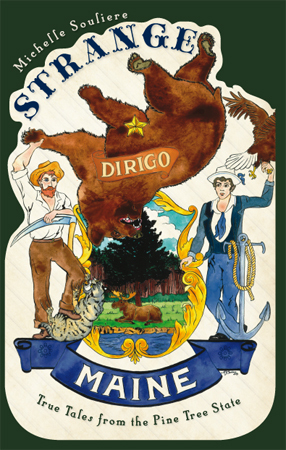Two books that seemed to offer fun summer reading provided that and a good deal of substance as well. In fact, David Buckman’s “Bucking the Tide: Making and Discovering the Wild New England and Fundy Coast in a $400 Yacht” and Michelle Souliere’s “Strange Maine: True Tales From the Pine Tree State” are modest, tightly written volumes for all seasons.
Buckman began in his native New Hampshire day-sailing on Lake Winnipesaukee and then ventured along the coast, in increments, from Narragansett Bay in Rhode Island to Canada’s Bay of Fundy. It begins with a dream to cruise the coast, buy a boat and, as time permits, simply enjoy things with Buckman’s wife, Leigh, and friend Scott “Cleve” Smith. The time was the late ’70s, and the author found a leaky 18-foot wooden sloop languishing in a boatyard.
Christened the Leight, the vessel took a good deal of fixing up and some odd modifications. As Buckman notes, “The transom was split across its breadth and there was a good- sized area of rot on the starboard quarter that had spread to the topside planking where it could easily be run through with the blade of a jackknife. I agonized about how to approach this, whether to patch the cavity with epoxy, like a dentist might repair a decayed tooth, or take the more laborious approach and replace it. While wooden boat purists would blanch at my methodology, I cut two inches of the stern, landed a new transom in sound wood and had the world’s only 18-foot, 10-inch Lightning.”
After a summer on Winnipesaukee, David and Cleve decided on a shakedown cruise out of the Portland Yacht Club (Falmouth) on Casco Bay. The sailor-author’s description of what he terms “the Casco Fiasco” could probably stand in for anyone’s first sail (unless one actually grew up on the water):
“Less than an hour into our shakedown cruise we’d gone aground, were lost, and had a sinking feeling that we were well over our heads. In the midst of electric confusion enveloping us, the sound of a power lawn mower slowly penetrated our consciences. Heading for that beacon of civilization, I cursed the pregnant silence that followed its few minutes of operation.”
It was the beginning of a great, endless adventure, as anyone who has seriously sailed will know. Buckman is a clear, thoughtful writer with a delightful sense of humor.
Strangely, the only major accident occurred not at sea, but on the lake.
Michelle Souliere’s “Strange Maine: True Tales From the Pine Tree State” is equal to the adventures of “Bucking the Tide.” So many recent titles having to do with ghosts and oddities in our neighborhood have been based on previous articles without much critical assessment. It is pretty easy to find a 19th-century article on a given topic and parrot it back or retell an urban myth. None of that with Souliere.
The editor of the delightful “Strange Maine Gazette” and similarly named blog and the operator of Portland’s Green Hand Book Store, Souliere is a practical historian who approaches each incident with interest, skepticism, common sense, reverence and humor.
Her first words are eminently practical: “This book is not intended as a guide to trespassing.”
Divided into five chapters — “The Witch’s Grave and Other Marked Monuments,” “Crime on the Coast and Elsewhere,” “Places that Go Bump in the Night,” “What Monsters Roam in the Maine Woods?” and “Oddities and Ephemera,” the volume is notable for organization and readability.
Souliere offers not only the unusual places that adhere to our soil, such as Brian Read’s Recycle Zoo in Washington or Hubcap Heaven in Littleton, but terrific, documented stories about how, when and why such wonder-filled curiosities came about.
The author also grapples with some things that have annoyed me over the years. A case in point is the long-broken Celtic cross and tomb of “W. A. Baker” in Portland’s Western Cemetery.
This has been called “The Witch’s Grave.” Local kids told stories about souls being sucked out at midnight if people stood too close and the mysterious Latin word “diaconus,” supposedly meaning demon.
Serious study found that the word was “deacon” in English, and that the records taken by Virginia Greene in 1938 should have read, “Rev. John W. C. Baker, 1837-1871.”
Not only did Souliere identify the correct resident, but she tracked his obituary to the Eastern Argus. Persistence of memory among Mainers was slight indeed.
Here, a member of St. Luke’s Cathedral was forgotten fewer than 100 years after his death. the 1970s, local children thought or probably hoped that whoever was buried beneath the eroding stone was a witch.
Poor Rev. Baker. Now that is strange Maine. Thanks to Michelle Souliere, her curiosity and good scholarship, the forgotten clergyman may now rest in peace, under his real name.
William David Barry is a local historian who has authored/co-authored five books including “Tate House: Crown of the Maine Mast Trade” and the novel “Pyrrhus Venture.” He lives in Portland.
Send questions/comments to the editors.


